January 2007 (Part 3)
SELECTION OF QUESTIONS AND ANSWERS
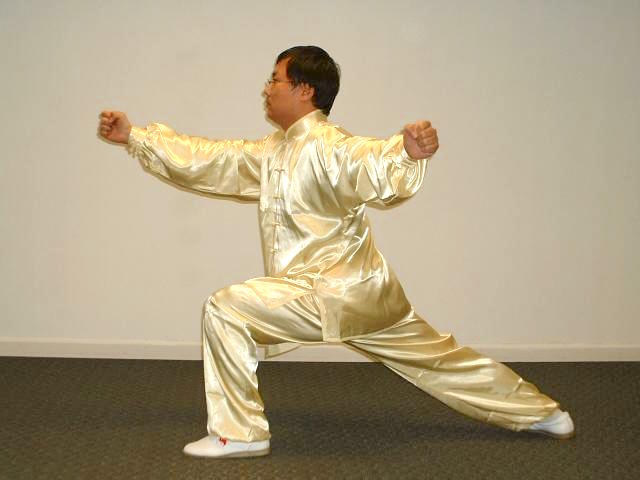
Many people are puzzled that the Shaolin Kungfu they see is not like what they think it is. They may have an answer if they know that there are different versions of Shaolin Kungfu. The “Tantui” demonstrated by Sifu Shang Gao above is Northern Shaolin, which is sometimes called Henan Shaolin Kungfu because it originated from the northern Shaolin Monastery in Henan Province. The picture above is reproduced from http://www.shang-wu.com/pic-tantui.php
Question 1
My entreaty for your help refers to my father. He is 72 years old and two years ago doctors made the diagnosis of a spiteful tumor in his gall bladder. The experts cannot help him now and they tried to give him a duct for better flow of the bile-fluid. The tumor was developed from an “very old” liver-tissue. From the beginning of illness till now my father has been very painful and there have been a lot of mistakes by the doctors. Now my mother and I have to attend to him and take care that my father does not get hepatitis.
He has lost so much of his weight that he cannot go around for longer than 5 to 10 minutes. My idea is to consult a chi kung master. He really wants to become healthy, but he is too weak. But where can I find a master or someone who would really help a person with such sickness? When I read your book and your column in “Inside Kungfu” magezine”, I take the chance to write you. In this moment I think you are my last hope or possibility to help my father.
— Peter, Germany
Answer
I am sorry to hear of your father's situation. The good news is that it is not impossible that he may regain good health again. It will be inspiring to know that I have students who were older than your father in similar bad situations who recovered, and are now healthier than before.
But I would like you to know this clarification. What I say about your father is a possibility, not a certainty. In other words, it is possible that you father will recover, but there is no guarantee that it is certain to happen.
While it is not essential, it is helpful and inspiring to know the philosophy behind the healing via chi kung. First of all you need to understand that chi kung uses a paradigm very different from that of Western medicine. A paradigm is not a set of facts; it is a way of looking at things and explaining them.
Like most people, you may be so used to the Western medical paradigm that you may, consciously or unconsciously, think that it is the only way to look at health and illness. This is not true, there are other ways of looking at health and illness. Which way is the best is irrelevant. What is important is which way gives the desired result for a particular situation.
Suppose you had very high fever, and a Western doctor said that you had been infested by powerful bacteria. By taking the appropriate antibiotics, the bacteria would be killed and you would recover. This is looking at your situation from the Western medical paradigm, and it is the best in this situation as it brings the desired result. Had you used the chi kung paradigm, it would not be as effective.
The way you described your father's situation was using the Western medical paradigm. By you own admission, this paradigm had not brought about the desired result. Thus, it would be wise to use the chi kung paradigm in his case.
From the chi kung paradigm, your father would not be seen as he had a gall balder tumour or that he might develop hepatitis. This does not mean that the tumour was not there or that hepatitis would not develop. It means that if we use the chi kung paradigm we would see the same situation differently and explain it differently.
In the chi kung paradigm, your father's situation is described as energy blockage. You may understand the dictionary meaning of “energy blockage”, but you may not actually know what it means. In simple language, it means that the energy that flows to your father's gall bladder and all his glands, tissues, muscles and systems, is being blocked from doing the work it does naturally. Actually, from the chi kung perspective all diseases are fundamentally caused by energy blockage.
If you find this explanation odd or even ridiculous, like some people do, it is because you are not familiar with this paradigm — just as people who are not familiar with the Western medical paradigm may find Western methods odd or ridiculous. But the crucial point is that in such cases like your father's where the cause of the illness is unknown, as in cancer, hepatitis, heart failure, diabetes, chronic pain, asthma, depression and many others, if you use the Western medical paradigm the disease are consider “incurable”.
But if you use chi kung paradigm, the fundamental cause is defined, and if it can be overcome, the patient will recover as a matter of course. In other words, if the patient can ensure a smooth flow of energy that clears his energy blockage, he will he healthy again. It is really that simple — so simple that some people wonder whether it works. Of course it works. It has worked for the largest population of the world for the longest period of history.
Some people may ask, “Isn't cancer caused by cell mutation, and hepatitis caused by viral infection?” That is looking at illness from the Western medical paradigm. From the chi kung paradigm, they are caused by energy blockage.
A logical follow-up question could be as follows. Isn't it ridiculous that energy blockage is the cause of cancer, hepatitis and all other diseases? It is ridiculous if viewed from the Western medical paradigm. If viewed from the chi kung perspective, it is perfectly reasonable.
Energy blockage is the fundamental cause, and the disorder can be manifested in many different symptoms. Western medicine gives a name to different symptoms, such as cancer, hepatitis, asthma, depression and so on.
As an analogy in economic problems, blockage of cash flow is the fundamental cause, it may have different manifestations like inability to repay loans, having to live in substandard housing, or frequent quarrelling with the spouse. Just as the different economic ills will go away when smooth cash flow is regained, different medical ills will go away when smooth energy flow is restored.
A good way to restore energy flow is to practice high level chi kung from a genuine master. If he practices low level chi kung, the chi flow may not be powerful enough to clear his blockage. If he learns form a mediocre instructor, he may only learn the outward form of the chi kung exercise but not the necessary skills.
More importantly, he must practice consistently according to the teacher's instructions. This sounds obvious, but students often neglect this essential condition. For example, they are asked to practice daily for nine months. But they practice daily for three days. This is not following instruction. They are asked not to think of anything during practice. But they intellectualize during practice. Again this is not following instruction.
I would suggest that your father learned from one of our certified Shaolin Wahnam instructors as soon as possible. Please see our List of Certified Instructors. When he is fit enough to travel, he should attend my Intensive Chi Kung Course in Malaysia.
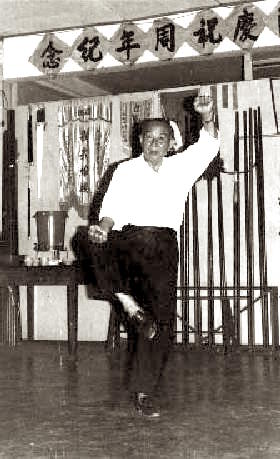
Many people know about Northern Shaolin and Southern Shaolin, but they may not know that there are four versions of Southern Shaolin. The White Crane Kungfu demonstrated by Sifu Lee Kiang Ke above is Fujian Shaolin Kungfu as it originated from the southern Shaolin Monastery in Fujian Province. The picture above is reproduced from http://www.aei.ca/~straycat/kungfu/pgmaster.html
Question 2
I want to ask you about White Tiger Kung Fu. Can you please tell me about this system of Kung Fu?
— Cesar, USA
Answer
I did not know about White Tiger Kungfu until I read about it on the internet and in our Shaolin Wahnam Discussion Forum. From information received online, the First Patriarch of White Tiger Kungfu was one of the five famous Shaolin grandmasters who lived about 150 years ago during the Jing Dynasty, called Foong Tou Tak. The other four Shaolin grandmasters were Ng Mui, Pak Mei, Chee Seen and Miew Hein. (Please note that the names are in Cantonese pronunciation, the Chinese dialect popular among masters who spread Shaolin Kungfu out of China.)
I also viewed some of the video clips showing White Tiger Kungfu demonstrated by a current White Tiger grandmaster and it confirmed what I would expect to be the type of kungfu coming from Foong Tou Tak.
However, according to what I know, the style of kungfu from Foong Tuo Tak was called Wudang Shaolin Kungfu.
There were five versions of Shaolin Kungfu, namely
- Henan Shaolin Kungfu from the northern Shaolin Monastery in Henan
- Fujian Shaolin Kungfu from the southern Shaolin Monastery at Quanzhou in Fujian
- Guangdong Shaolin Kungfu from disciples of the Venerable Chee Seen (who taught at the southern Shaolin Monastery at Nine-Lotus Mountain also in Fujian) who spread the art to Guangdong
- Ermei Shaolin Kungfu from Pak Mei who taught on Ermei Mountain in Szechuan
- Wudang Shaolin Kungfu from Foong Tou Tak who taught on Wudang Mountain in Hubei
Wudang Shaolin Kungfu and Ermei Shaolin Kungfu were later shortened to Wudang Kungfu and Ermei Kungfu.
Please note that the Wudang Kungfu of Foong Tou Tak was different from the Wudang Kungfu of Zhang San Feng who lived many centuries earlier. (Similarly the Shaolin Kungfu, or Shaolin Wushu, taught by modern Shaolin monks is very different from the Shaolin Kungfu taught in Shaolin Wahnam.)
I am not sure whether White Tiger Kungfu is the same as the Wudang Kungfu of Foong Tou Tak though both came from the same grandmaster. But if someone performs White Tiger Kungfu, I would have easily thought it to be Wudang Kungfu.
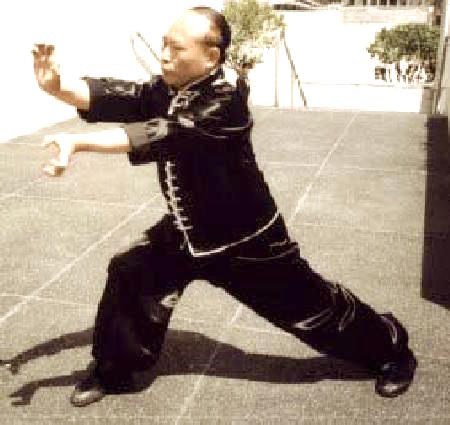
Another version of Southern Shaolin Kungfu is Guangdong Shaolin Kungfu, which also originated from the southern Shaolin Monastery in Fujian but was spread to Guangdong Province. The style of Guangdong Shaolin demonstrated above by Sifu Y.C. Wong is Hoong Ka (Hung Far). The picture above is reproduced from http://www.tigercrane.com/hghf.html
Question 3
I have read that there is a lot of internal training in this Kung Fu system. I have also read that it is a rare system.
Answer
It is best that you address this question to masters of White Tiger Kungfu. But I would comment on the Wudang Kungfu of Foong Tou Tak.
Yes, there is a lot of internal training in this kungfu system. External methods like punching sandbags, striking poles and weight training (like holding stone-locks and wearing copper rings), which are quite common in many Shaolin styles of the Fujian and Guangdong versions, are normally not used.
The main internal methods are stance training and breath control. In many ways Wudang training methods are similar to, though may not be the same as, those in Shaolin Wahnam. When a practitioner has developed sufficient internal force from his stance training, by practicing any of his kungfu moves with appropriate breath control, he can increase his internal force. This may be difficult for those not familiar with internal art training to comprehend.
Yes, Wudang Kungfu of Foong Tou Tak is a rare system. Not only the internal aspects are rarely known, even its external forms are not commonly taught. Taijiquan is an interesting comparison. The external forms of Taijquan are commonly taught, but very few Taijiquan practitioners really experience its internal aspects.
Question 4
I have read that it uses a technique called “Imprint Palm”. Can you tell me what “Imprint Palm” does? Is it the same as “Cosmos Palm”?
Answer
“Imprint Palm” refers to a technique, whereas “Cosmos Palm” refers to a type of force. To give another example, “Chopping Palm” is a technique, whereas “Iron Palm” is a type of force.
If you lift up your hand and chop down with the base of your palm, you execute a technique called “pi zhang” or “chopping palm”. To make your technique effective in combat, you need to back it up with some force, which may be trained externally or internally.
If you strike your palms on a bag filled with iron-fillings a few hundred times everyday for three years, you will develop a type of force called “Iron Palm” force. Alternatively, if you practice certain chi kung exercises like “Pushing Mountains” a few hundred times everyday for three years, you will develop a type of force called “Cosmos Palm” force. If you strike an opponent using the “chopping palm” technique with either “Iron Palm” force or “Cosmos Palm” force, it can be very distructive.
On the other hand, if you place your palm flat on an opponent's body and exert force, you use a different technique. This technique is called “yin zhang” or “imprint palm”. If you are not trained in internal force, even if you are trained in external force, including Iron Palm, your “imprint palm” on your opponent would not be very destructive. But if you are trained in internal force, such as Cosmos Palm, you may damage his internal organs severely without leaving any external marks.
However, external force may become internal at advanced levels. The incident of Sifu Ku Ru Zhang, the great Northern Shaolin master famous for his Iron Palm, hitting a horse was an example. Challenged by a Russian master who insulted the Chinese people that they were not even capable of beating his horse, the Shaolin master gave the poor animal a gentle tap of his Iron Palm, a palm technique known as “pai zhang” or “tapping palm”. The animal collapsed on the spot. Autopsy showed that the internal organs of the horse were damage although there were no external marks.
Techniques like “imprint palm” and “tapping palm” were frequently used by internal art masters in the past although modern students of internal arts have little exposure to them. This is no surprise. Many modern internal art practitioners have no experience even of chi, the most basic ingredient for internal force. Some do not believe chi exists although they claim to practice internal arts.
“Imprint Palm” is not the same as “Cosmos Palm”. One refers to a technique, the other refers to a type of internal force. “Imprint Palm” requires internal force to be effective. The internal force may come from “Cosmos Palm” or from other types. On the other hand, “Cosmos Palm” can be used in “Imprint Palm” or in other techniques.
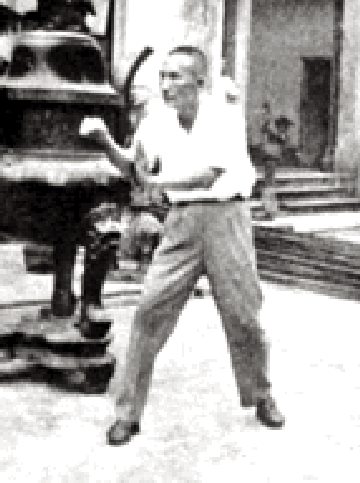
The other two versions of Southern Shaolin Kungfu are rare. One of them is Ermei Shaolin Kungfu, often shortened to Ermei Kungfu, named after the Ermei Mountain in Szechuan Province where the Shaolin grandmaster, Pak Mei, taught. Three styles originated from Pak Mei, who was a Taoist monk. One of these styles is Pak Mei Kungfu, demonstrated above by Sifu Cheung Lai Chuen. The picture is reproduced from http://www.pakmei-uk.com/index-old.htm
Question 5
I'm a newcomer to Qigong. I like Qigong very much because I know the wonderful effects of Qigong such as preventing and curing illness, and giving good health. I'm learning and practicing Qigong with a local sifu. I practice Qigong at night (before bedtime), but I often got headache. I think the Qi (or energy) is blocked in my brain (head) and I get insomnia after that.
I tried many ways to direct Qi from my head such as thinking it flows to my hands, but nothing was effective. I still can't sleep. Sifu, please give me your instructions so that I could overcome this problem.
— Hoang Thach, Vietnam
Answer
It seems that you have practiced wrongly and have caused a blockage in your head resulting in headache and insomnia. Some likely causes for the wrong practice were being tensed, intellectualizing, worrying or keeping your mouth close during practice.
The following remedial exercise can help you to overcome the problem. Practice it early in the morning in the open if feasible. Stand upright and be relaxed. Don't think of anything. This is important. Don't think, for example, whether you are practicing correctly or whether the remedial exercise will help you.
Smile from your heart. Don't worry how you do it, just do it. Then breathe out gently about ten times with your mouth open wide. You need not worry about breathing in. Just breathe out gently with your mouth open wide about ten times, with a gentle pause in between each breathing out if you wish.
Then close your eyes gently and keep your mouth open gently. Now don't worry about your breathing. “Don't worry about your breathing” means don't worry about your breathing. It does not mean holding your breath. If you find that you are breathing in naturally, that is fine. If you find that you are breathing out naturally, that is fine too. But if you wonder whether you should breathe in or breathe out, or purposely regulate your breathing, that is incorrect. That is worrying about your breathing.
And don't do anything or think of anything. It means that if your chi flow moves you, that is fine. Don't tense your muscles to stop the movement. If you don't move, that is fine too. Don't try to use your muscles to move your body. Practice this exercise everyday until your problems disappear, or as long as you like. Besides overcoming your headache and insomnia, this exercise also brings other benefits.
Question 6
Is it possible to receive beneficial chi if one is not too well at the moment?
— Toh, Malaysia
Answer
Of course. In fact, today most people practice chi kung because they want to get well, particularly when conventional Western medicine considers their illness “incurable”. If you refer to the Comments Section of my website or to the Testimonials at the Shaolin Wahnam Discussion Forum, you can find many testimonials of such cases.
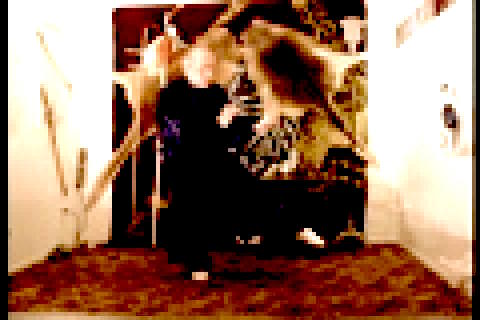
Another rare Southern Shaolin style is Wudang Shaolin Kungfu, often shortened to Wudang Kungfu, named after the Wudang Mountain where another Shaolin grandmaster, Foong Tou Tak, taught. One should note that this Wudang Kungfu from Foong Tou Tak is different from the Wudang Kungfu of Zhang San Feng, the First Patriarch of Taijiquan. Foong Tou Tak was also a Taoist monk. White Tiger Kungfu, shown by Sifu Doo Wai above, was a style originated from Foong Tou Tak. The picture is reproduced from http://www.tigerkungfu.com/
Question 7
Also I have glaucoma. Can it be affected adversely if I practise chi kung?
Answer
On the contrary, practicing high level chi kung can help you overcome glaucoma and other eye problems. The “Shaolin Eight Techniques for Eyes” are very useful. I have described these eight techniques in some details in my question-answer series. Please do a search for the exercise.
Although I am over 60 and often work on my computers many hours a day, I do not wear glasses, including when reading and driving. I am thankful to the masters who have passed on to us the “Shaolin Eight Techniques for Eyes”.
Question 8
I'm around 60 now and feel signs of ageing. I have soft tissue pain on my upper left arm and high blood pressure for 8 years too. The Western medication I take daily, comprising atenolol (beta blocker) and chlorthalidone (diuretic), makes me tired almost the whole day and I am thinking of switching to Chinese medicine.
Answer
There is a Chinese saying that taking medicine is not as effective as taking good food, and taking good food is not as effective as taking chi, i.e. practicing chi kung. I would recommend that you attend my Intensive Chi Kung Course. Please see my website and apply to my secretary at secretary@shaolin.org if you intend to attend.
You will learn in just a few days sufficient chi kung skills and technique that if you practice them daily you will not only overcome all your health problems, including pain and high blood pressure, and without having to take any medication (Chinese or Western), you will also have good health and mental freshness that make you realize why some people say that “life starts at 60”.
I am over 60 but feel healthier than when I was 20! I am not joking. I am thankful that I still have the vitality and mental freshness to enjoy life as a young man. I travel about nine months a year all over the world. I just returned from a month-long trip to the USA, driving from New York on the Atlantic coast to Chicago in the north, then down the length of the county to Jacksonville in the south, and across from east to west to Los Angeles on the Pacific coast.
I share the secrets of my health and vitality in my Intensive Chi Kung Course. Many people have benefited. Such a course is conducted only a few times a year. You shouldn't miss it.
LINKS
Selected Reading
- Two Big Secrets in Single Tiger Emerges from Cave
- Free Sparring in Finland using Kungfu Patterns
- What You Learn at the Intensive Shaolin Kungfu Course
- In Search of Kungfu Secrets
- Sharing Secrets in Combat Application
